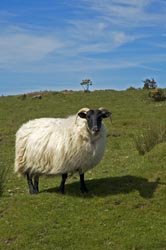Microsatellite marker set for Blackface sheep
For grassland areas of Europe, sheep farming can form the basis of the local economy. The sheep milk industry is expanding and has undeveloped potential and there is a strong market for the meat. From an ecological point of view, grazing by sheep represents a means by which the ecophysiology of the sward can be maintained. In this way, the ecosystem will not progress into a succession where the characteristic plants and animals may be lost. Members of GENESHEEPSAFETY, a project funded by the EC, performed research with genomics as a means by which the quality and safety of sheep products can be improved. Traits such as milk and meat yield and quality and disease resistance are important factors for selective breeding systems. Improved breeding programmes and fitter sheep mean that there is less need for input of pesticide chemicals into the food chain. Workers at the Roslin Institute in Scotland investigated the occurrence of useful genetic markers in Blackface sheep. This breed is well adapted to survival in upland areas as their fleece protects them from the harshest of weather all too evident in these microclimates. Commercially, their wool is a speciality in the industry and their meat is of high quality. The team produced a list of microsatellite markers that could be used to identify useful quantitative trait loci in this and other similar projects. Microsatellite DNA consists of short repeating units that are usually genetically neutral. As such, these are ideal for use as markers. For each sire (or breeding ram), up to 30 markers were tested per chromosome for a resulting panel or set. Because of the technique used, the panels of markers were individual for each sire. The next step was to genotype all progeny and grandparents for the markers of the sires to ensure that those selected were informative and useful. Cost efficiency is important in studies of this type because of the sheer number of genes in a genome and the lengthy procedures used. The set of markers produced was used in the Institute's sheep population and can continue to be used in other commercial herds for verification purposes. In line with the aims of the project, there is full accessibility to the information for any interested party involved in the improvement of health and product quality in sheep. Cooperation amongst breeders across Europe and worldwide can promote this expanding and important industry.







